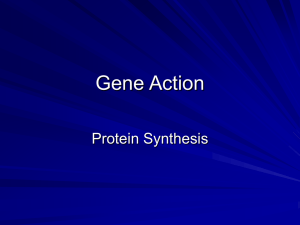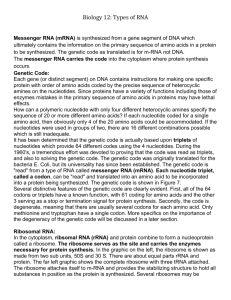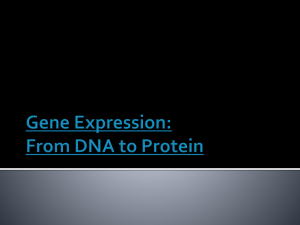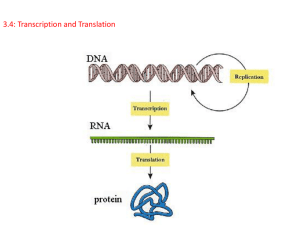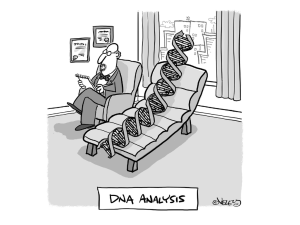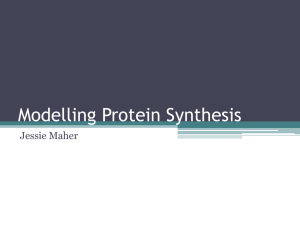Protein Synthesis
advertisement
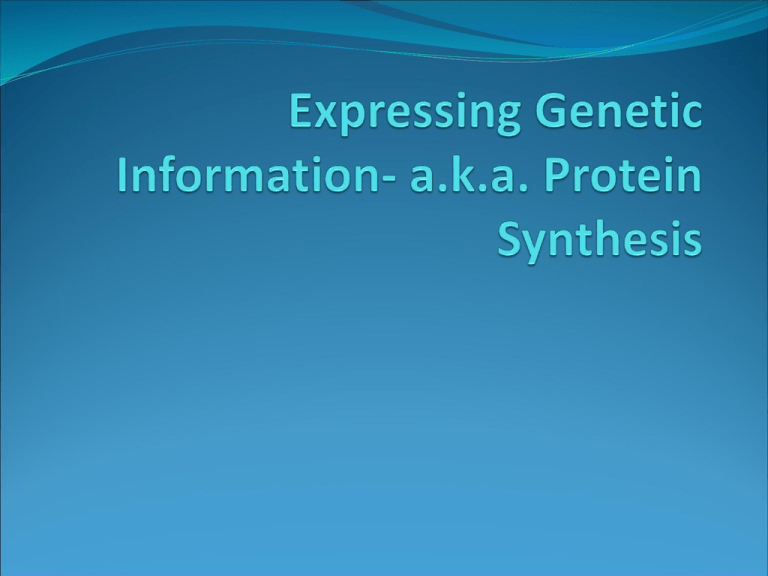
Gene- a series of nucleotides found on a strand of DNA that codes for a particular protein Protein Synthesis- when the info stored on a gene is “read” and then used to make a protein 3 Parts to Protein Synthesis: 1. Transcription- creating RNA from DNA (occurs in the nucleus) 2. Processing- When RNA is trimmed of its non-proteincoding nucleotides, made small enough that it can exit the nucleus 3. Translation- The RNA assembles a specific sequence of amino acids to make the desired protein (occurs on the ribosome) The Big Picture!! • There are 3 macromolecules involved in Protein Synthesis • DNA makes RNA • RNA codes for proteins • Proteins carry out ALL of the cell’s important functions and activities Recall: There are Two Types of Nucleic Acids DNA – Deoxyribonucleic Acid RNA – Ribonucleic Acid Similarities: 1. 2. 3. 4. Nucleic acids Store genetic material Made up of strands of nitrogen bases Follow some type of Base Pairing Rules Differences Between RNA/DNA DNA: Double-stranded Cytosine-Guanine Adenine- Thymine 5-carbon sugar = deoxyribose Never leaves Nucleus RNA: Single-Stranded Cytosine –Guanine Adenine- Uracil 5-carbon sugar = ribose Can leave nucleus RNA types Three major types: (to be discussed further) 1. 2. 3. Messenger (mRNA) Ribosomal (rRNA) Transfer (tRNA) mRNA Temporary copy of a gene that encodes for a protein; Provides the pattern that determines the order and types of amino acids making that protein. Very unstable, cell WILL try to break it down unless it is processed Contain codons (3-base sequence) Precursor mRNA – exists in nucleus Mature mRNA – genes to be copied by ribosome (has been processed) exists in cytoplasm rRNA Makes up 80% of RNA in cells Used to make portions of ribosomes in cells in combination with proteins. Can be free floating Or attached to Endoplasmic reticulum (RER) tRNA Free floating in cell Enzyme attaches ONE tRNA to ONE amino acid(charged tRNA) tRNA ‘carries’ the amino acid to ribosome to add to the growing polypeptide (protein) chain Contains an anti-codon sequence (3-bases as bottom of tRNA), which is complementary to each codon The Genetic Code• The nucleotides serve as the four “letters” of the DNA “alphabet” (A,C,G, & T) • 3 nucleotides make a Codon (ex. AAG) • Codons code for an Amino Acid (AAG codes for lysine) • Amino Acids are the building blocks for proteins • Since there are 4 nucleotides, when three are grouped together, there are 64 possible triplet combinations (43 = 64) • However, there are only 20 amino acids so some amino acids have more than one codon (ex. GGA, GGC, and GGG all code for glycine) Summary: DNA = permanent copy (like your hard drive) RNA = Temporary copy (similar to floppy copy) Leads up to two of the most important processes: Transcription and Translation animation Part 1: Transcription The building of mRNA, tRNA, and rRNA (takes place in the NUCLEUS) STEPS: Initiation: RNA polymerase binds to the gene’s promoter on the template strand of DNA(a specific sequence of the DNA that acts as a “start signal” for transcription) RNA polymerase unwinds and separates the two strands of the DNA. Elongation: RNA polymerase adds and then links complementary RNA nucleotides as it “reads” the gene”. Termination: A “stop” signal on the DNA tells the RNA polymerase to detach from the DNA and release the RNA molecule. Tutorial/Quiz Part 2: RNA Processing Before leaving the nucleus…….. 1. A cap (methyl-guanine or mG) is added by enzymes to the starting end of the mRNA molecule 2. A poly-A tail is added to the end of the mRNA 3. The molecule is spliced. Introns are removed (non-coding nucleotides) and exons remain. RNA Processing Animation Part 3: Translation Tutorial The assembly of a protein (occurs on the ribosome in the cytoplasm) 1. mRNA leaves the nucleus through the nuclear pore and forms a functional ribosome with two ribosomal subunits, and a tRNA 2. Initiation: The mRNA “start” codon AUG is oriented in a region of the ribosome called the P site where the tRNA molecule carrying methionine can bind to the start codon. Translation- cont. (another animation) 3. The codon in the area of the ribosome called the A site is ready to receive the next tRNA. 4. Elongation: Both the A site and the P site are holding tRNA molecules- each carrying a specific amino acid. A peptide bond forms between the adjacent amino acids 5. The tRNA in the P site detaches and leaves its amino acid behind 6. The tRNA in the A site moves to the P site. The tRNA carrying the amino acid specified by the codon in the A site arrives. 7. Termination: Steps 4-6 are repeated until a stop codon is reached. Translation animation One more Translation animation If a segment of DNA is: TAC AAA GTA ACT The mRNA strand would be: AUG UUU CAU UGA This would code for the following amino acids: Met Phe His Stop Types of Mutations Point Mutation- a change of one or just a few nucleotides in a gene. 3 Main Types of Point Mutations: •Substitutionone nucleotide is replaced by another. •Insertion – an extra nucleotide is added. •Deletiona nucleotide is omitted. Mutations can be “Silent” When a substitution mutation in a base pair does not result in a change in the sequence of amino acids in a protein Mutations can be “Neutral” A change in a base pair results in an amino acid change, but the new amino acid has the same chemical properties as the old amino acid. (ie hydrophobic to hydrophobic; acidic to acidic) Mutations can be “Missense” a mutation results a change in an amino acid where the new amino acids has a different property than the old amino acid. The protein with the new primary structure may have reduced or no activity. Mutations can be “Nonsense” A mutation results in a new “stop” translation condon formed before the naturally occurring one. Translation is stopped prematurely and a shortened protein is made. Mutations can result in “Frameshifts” A deletion or insertion of one base results in a change in the translational reading frame
